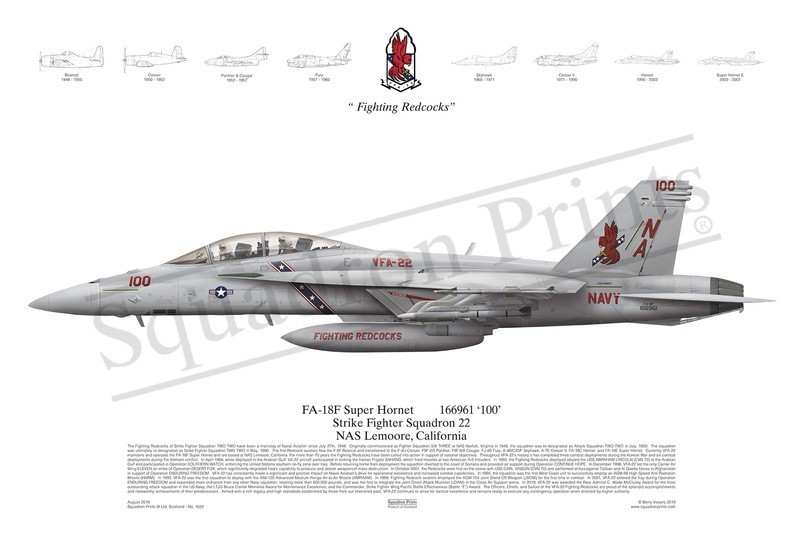#1522 FA-18F Super Hornet

Purchased products will not feature the Squadron Prints watermark
Description
Squadron Prints Lithograph No 1522 - 166961 '100', FA-18F Super Hornet, Strike Fighter Squadron 22 (VFA-22), NAS Lemoore, California.
The Fighting Redcocks of Strike Fighter Squadron TWO TWO have been a mainstay of Naval Aviation since July 27th, 1948. Originally commissioned as Fighter Squadron SIX THREE at NAS Norfolk, Virginia in 1948, the squadron was re-designated as Attack Squadron TWO TWO in July, 1959. The squadron was ultimately re-designated as Strike Fighter Squadron TWO TWO in May, 1990. The first Redcock aviators flew the F-8F Bearcat and transitioned to the F-4U Corsair, F9F-2/5 Panther, F9F-6/8 Cougar, FJ-4B Fury, A-4B/C/D/F Skyhawk, A-7E Corsair II, FA-18C Hornet, and FA-18E Super Hornet. Currently VFA-22 maintains and operates the FA-18F Super Hornet and are based at NAS Lemoore, California. For more than 70 years the Fighting Redcocks have been called into action in support of national objectives. Throughout VFA-22’s history it has completed three combat deployments during the Korean War and six combat deployments during the Vietnam conflict. In April 1988, while deployed to the Arabian Gulf, VA-22 aircraft participated in sinking the Iranian Frigate SAHAND, which fired missiles at two American A-6 Intruders. In 1993, the Fighting Redcocks deployed aboard the USS ABRAHAM LINCOLN (CVN 72) to the Arabian Gulf and participated in Operation SOUTHERN WATCH, enforcing the United Nations southern no-fly zone over Iraq. Before returning home from deployment the squadron diverted to the coast of Somalia and provided air support during Operation CONTINUE HOPE. In December 1998, VFA-22 led the only Carrier Air Wing ELEVEN air strike of Operation DESERT FOX, which significantly degraded Iraq's capability to produce and deliver weapons of mass destruction. In October 2001, the Redcocks were first on the scene with USS CARL VINSON (CVN 70) and performed strikes against Taliban and Al Qaeda forces in Afghanistan in support of Operation ENDURING FREEDOM. VFA-22 has consistently made a significant and positive impact on Naval Aviation's drive for operational excellence and increased combat capabilities. In 1985, the squadron was the first West Coast unit to successfully employ an AGM-88 High Speed Anti-Radiation Missile (HARM). In 1993, VFA-22 was the first squadron to deploy with the AIM-120 Advanced Medium Range Air-to-Air Missile (AMRAAM). In 1999, Fighting Redcock aviators employed the AGM-154 Joint Stand-Off Weapon (JSOW) for the first time in combat. In 2001, VFA-22 entered the fray during Operation ENDURING FREEDOM and expended more ordnance than any other Navy squadron, totalling more than 650,000 pounds, and was the first to integrate the Joint Direct Attack Munition (JDAM) in the Close Air Support arena. In 2019, VFA-22 was awarded the Rear Admiral C. Wade McClusky Award for the most outstanding attack squadron in the US Navy, the LTJG Bruce Carrier Memorial Award for Maintenance Excellence, and the Commander, Strike Fighter Wing Pacific Battle Effectiveness (Battle "E") Award. The Officers, Chiefs, and Sailors of the VFA-22 Fighting Redcocks are proud of the splendid accomplishments and noteworthy achievements of their predecessors. Armed with a rich legacy and high standards established by those from our cherished past, VFA-22 continues to strive for tactical excellence and remains ready to execute any contingency operation when directed by higher authority.
You may also like
-
C-141B Starlifter
66-0128728 MAS, 445 MAW; 729 MAS, 445 MAW; 730 MAS, 445 MAWNorton AFB, California
